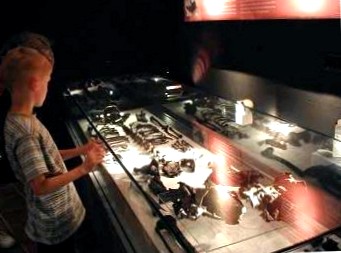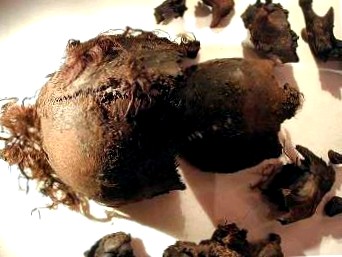Moora with a delicate hand
Female bog body is over 2600 years old
In lower saxony peat diggers found a corpse in a bog. At first everyone thought it was a crime victim or a dead body from the second world war, but the investigations of the archaeologists who were called in last revealed an age of 2650 years. Since the end of june, the girl from the uchter moor, the oldest bog body in northern germany, can now be seen in an exhibition in hanover.
Laid out is moora, as she was baptized in the meantime (the "girl from the uchter moor" is called moora), in the back room of the didactically very endeavored, but little attractive exhibition archaology country lower saxony, which still until 31. July in the "forum of the landesmuseum" opposite the marktkirche in hannover. In a rough table showcase lie her remains consisting of 100 individual parts: mainly brown discolored bones, but also leathery skin and tie remains, a scalp with red hair and a delicate little hand covered with skin, which digs benevolently from the afterlife.

(pictures: andrea naica-loebell)
The moor preserves what it has devoured. The eerie landscape has always appeared to people as a gateway to the gods, populated by spirits. Already in the neolithic period our ancestors began to build paths through the marshes surrounded by side swamps. The sacred marshes were for the germanic people the place where sacrifices were offered and according to the roman writer tacitus they also sank criminals and cowards there as punishment (the law of the germanic people).
Many famous bog corpses, such as red francis or tollund man, were probably executed there. Their bodies were preserved in the bog water, their hair turned red by appropriate chemical reactions. The lower saxony state museum explains in a publication why organic matter is often not completely decomposed in the bog:
In the past, the phenomenon of bog preservation was attributed to the exclusion of oxygen under water, acidity and the antimicrobial agent sphagnol. Today, the mummifying effect is attributed to the polysaccharide sphagnan, which is incorporated in the cell walls of the peat moss plants and is converted into humic acid after they die. Due to their binding effect of nitrogen and calcium, among other things, important growth nutrients are no longer available to the bacterial cultures – as a result of bone decalcification – and natural tanning is initiated. Tanning leads to the preservation of skin and hair.
Finds preserved with skin and hair are naturally very attractive for archaeologists. These corpses themselves tell a lot about their own history: what they died of, what they ate and how they died (flash tour through the world of bog bodies: bogpeople).
Moor crimi
Peat is traditionally an important fuel and is used today mainly in horticulture. Until the middle of the last century, the bales were dug by hand (the peat spade) and the workers repeatedly found archaeologically interesting material or well-preserved corpses in the process. From 1900 to 1955 the moor released in this way in northern germany alone about 120 swamp otzis. Most of them have not been preserved, they were simply reburied, sold as curiosities or even turned into magical remedies.
But then came industrial peat cutting, and today huge machines chop up the swampy soil. This is the reason why no bog body has been discovered in lower saxony since 1955. The dead bodies are crushed and disappear unseen.
It was a pure coincidence when in the fall of 2000 in the uchter moor (district of nienburg. The police rushed over and began their investigation.
During the second world war, an american airplane crashed in the area, and some of the crew members are still missing. And since 1969, a 16-year-old girl from the region has been missing. Further body parts were discovered by the officials and examined in detail. Soon it was clear that the dead woman was between 16 and 20 years old and that the body had not been tampered with in any way. A comparative genetic examination with the mother of the missing woman showed that there was no relationship. The dead teenager from the uchter moor remained an unknown, the criminal investigation department had no further clues and the investigation stalled.
But then, in early 2005, a delicate hand was discovered by peat workers in the immediate vicinity of the site where the body was found. The moor archaeologists from the lower saxony state office for the preservation of monuments walked the site and examined the cold hand. An archaeological context seemed probable to them and they initiated a radiocarbon dating of peat samples and of the body parts. The result surprised everyone: moora had lived in the pre-roman iron age, around 650 bc.
In the meantime, excavations are underway in the uchter moor, and moora itself will be the subject of further investigations by an interdisciplinary team after july 31. July, an interdisciplinary group of archaeologists, physicians, biologists, physicists, and chemists will further investigate moora to learn more of her secrets.

